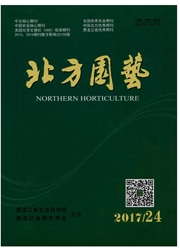

 中文摘要:
中文摘要:
以“紫抗1号”“紫抗2号”“四海升平”3个不同抗性的紫薇品种为试材,采用孢子悬浊液侵染法对试材进行病菌接种,测定了其接种后不同时间(24、48、72、96、120 h)内叶片的超氧化物歧化酶(SOD)活性,可溶性蛋白质、丙二醛(MDA)含量,以明确不同侵染时间下紫薇叶片中超氧化物歧化酶活性,可溶性蛋白质、丙二醛含量的变化规律,为白粉病抗性机制的研究提供依据。结果表明:抗病与免疫品种的SOD活性高于感病品种,且抗病与免疫品种的SOD修复快于感病品种;感病品种MDA含量不断上升,抗病品种与免疫品种的含量与变化趋势相近,变化较小,并始终低于感病品种;不用品种的可溶性蛋白质含量变化趋势基本一致,呈先上升后下降的趋势。
 英文摘要:
英文摘要:
Three different resistant varieties of L.indica,‘Zikang No.1’‘Zikang No.2’‘Sihaishengping’were used as materials,and the pathogen was inoculated with spore suspension of powdery mildew.After inoculation,the contents of soluble protein,MDA and activity of SOD in leaves were measured and the relationship between the resistance to powdery mildew and contents of soluble protein,MDA and activity of SOD of leaves were analyzed.The results showed that the activity of SOD in resistant cultivars and immune cultivars was higher than that of susceptible cultivars,and the SOD repair of resistant varieties and immune varieties were faster than susceptible varieties.The content of MDA in susceptible cultivars increased,and the content and variation trend of resistant varieties and immunized varieties were similar,the change was small and always lower than susceptible varieties.The content of soluble protein was similar to that of susceptible cultivars,and the change of soluble protein content was the same,which showed the trend of rising and then decreasing.
 同期刊论文项目
同期刊论文项目
 同项目期刊论文
同项目期刊论文
 期刊信息
期刊信息
